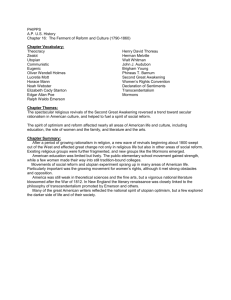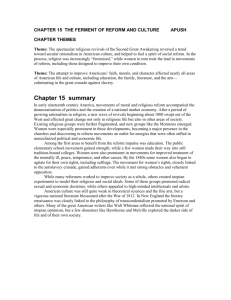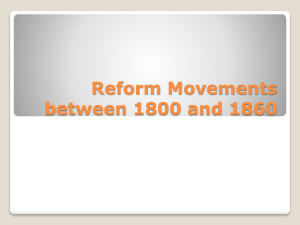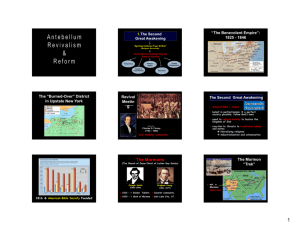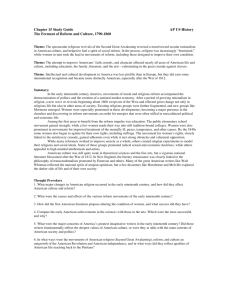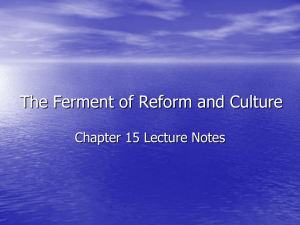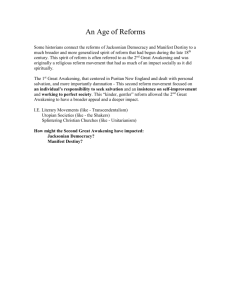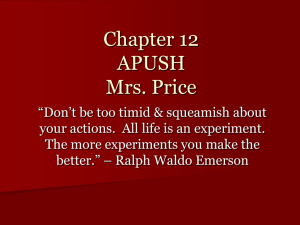File
advertisement
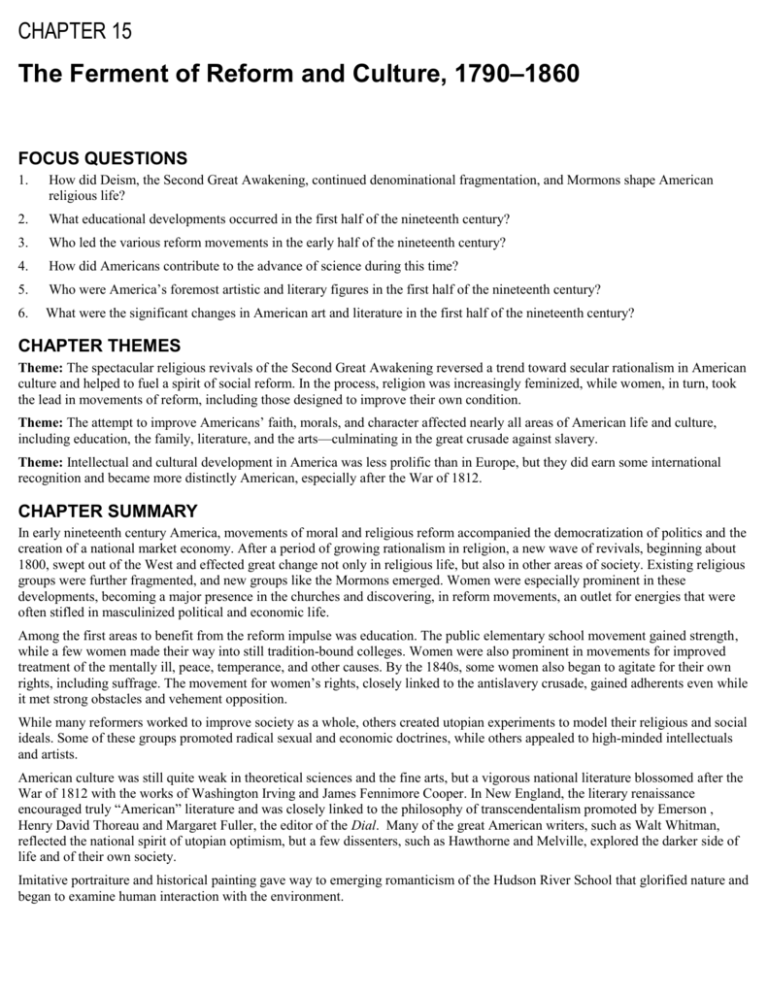
CHAPTER 15 The Ferment of Reform and Culture, 1790–1860 FOCUS QUESTIONS 1. How did Deism, the Second Great Awakening, continued denominational fragmentation, and Mormons shape American religious life? 2. What educational developments occurred in the first half of the nineteenth century? 3. Who led the various reform movements in the early half of the nineteenth century? 4. How did Americans contribute to the advance of science during this time? 5. Who were America’s foremost artistic and literary figures in the first half of the nineteenth century? 6. What were the significant changes in American art and literature in the first half of the nineteenth century? CHAPTER THEMES Theme: The spectacular religious revivals of the Second Great Awakening reversed a trend toward secular rationalism in American culture and helped to fuel a spirit of social reform. In the process, religion was increasingly feminized, while women, in turn, took the lead in movements of reform, including those designed to improve their own condition. Theme: The attempt to improve Americans’ faith, morals, and character affected nearly all areas of American life and culture, including education, the family, literature, and the arts—culminating in the great crusade against slavery. Theme: Intellectual and cultural development in America was less prolific than in Europe, but they did earn some international recognition and became more distinctly American, especially after the War of 1812. CHAPTER SUMMARY In early nineteenth century America, movements of moral and religious reform accompanied the democratization of politics and the creation of a national market economy. After a period of growing rationalism in religion, a new wave of revivals, beginning about 1800, swept out of the West and effected great change not only in religious life, but also in other areas of society. Existing religious groups were further fragmented, and new groups like the Mormons emerged. Women were especially prominent in these developments, becoming a major presence in the churches and discovering, in reform movements, an outlet for energies that were often stifled in masculinized political and economic life. Among the first areas to benefit from the reform impulse was education. The public elementary school movement gained strength, while a few women made their way into still tradition-bound colleges. Women were also prominent in movements for improved treatment of the mentally ill, peace, temperance, and other causes. By the 1840s, some women also began to agitate for their own rights, including suffrage. The movement for women’s rights, closely linked to the antislavery crusade, gained adherents even while it met strong obstacles and vehement opposition. While many reformers worked to improve society as a whole, others created utopian experiments to model their religious and social ideals. Some of these groups promoted radical sexual and economic doctrines, while others appealed to high-minded intellectuals and artists. American culture was still quite weak in theoretical sciences and the fine arts, but a vigorous national literature blossomed after the War of 1812 with the works of Washington Irving and James Fennimore Cooper. In New England, the literary renaissance encouraged truly “American” literature and was closely linked to the philosophy of transcendentalism promoted by Emerson , Henry David Thoreau and Margaret Fuller, the editor of the Dial. Many of the great American writers, such as Walt Whitman, reflected the national spirit of utopian optimism, but a few dissenters, such as Hawthorne and Melville, explored the darker side of life and of their own society. Imitative portraiture and historical painting gave way to emerging romanticism of the Hudson River School that glorified nature and began to examine human interaction with the environment. Main Ideas I. Second Great Awakening and its Impact on America A. New Denominations B. Social and Political Impact C. Deism and Unitarianism D. Story and history of the Mormons E. Impetus for Social and Cultural Change II: Changes in Education and Higher Learning III. Reform Movements and Changes to American Society A. Role that Women play in these changes B. Role that Second Great Awakening Plays in these changes IV. Reform Movements A. Prisons and Psychiatric Care - Dorothea Dix B. Temperance Movement - American Temperance Society C. Women’s Rights - Women’s Rights Convention at Seneca Falls - Lucretia Mott, Elisabeth Cady Stanton, Susan B. Anthony, Elisabeth Blackwell, Grimke Sisters D. Utopian Societies - New Harmony - Brooks Farm - Oneida - Shakers V. Scientific Achievements VI: Art and Literature A. Hudson River School, Architectural achievements, Literary figures and Transcendentalism
